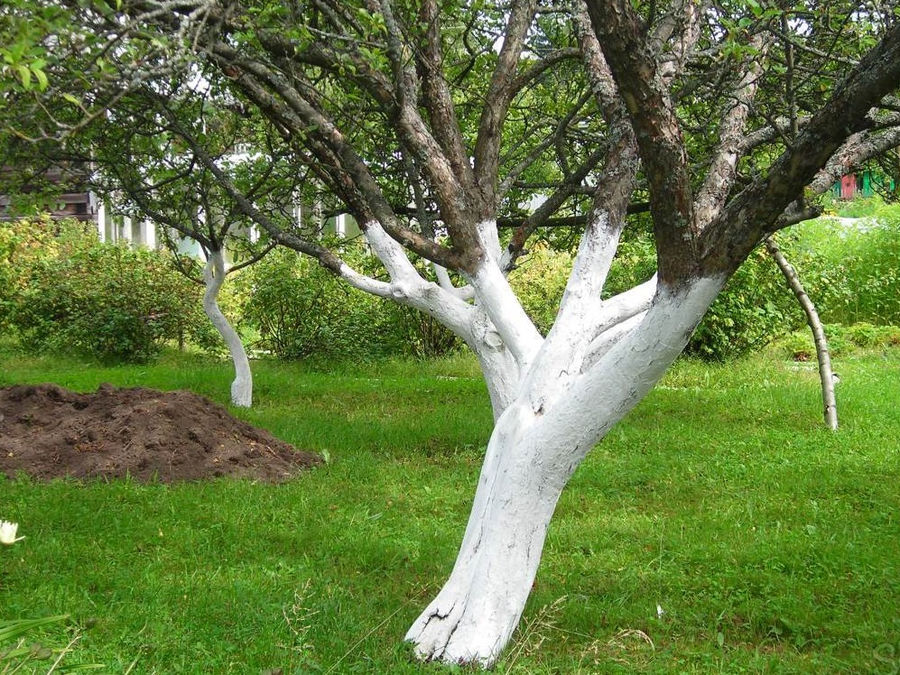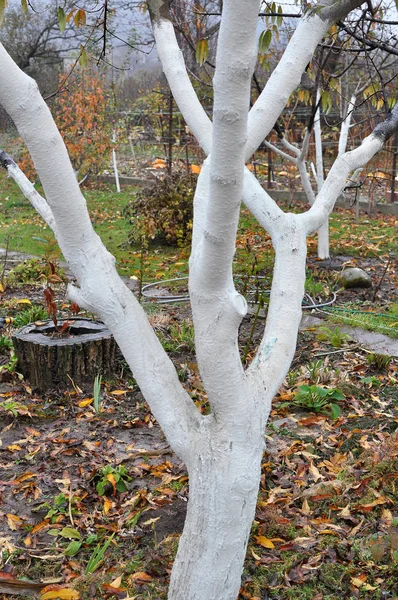
Taking care of its fruit trees is a guarantee of future abundant harvests! Among winter treatments, the application of an arboreal white (lime wash) is one of the most recommended. This natural product, made from slaked lime and vegetable oil, acts as a second skin for the trunk. It limits the aggressions of time and is proven to be one of the best insecticides around. Economical and formidably efficient!
The benefits of arboreal white
Frost and sun protection
The limewash constitutes first and foremost a physical barrier against climatic aggressions and excessive temperature variations, in particular by limiting the effects of frost or the burns caused by too strong a sun. Arboreal white thus attenuates the effects of the cold by slowing down the heating of the internal tissues of young trees exposed to winter sun. Protection continues in spring and summer: the light color of arboreal white reflects the sun’s rays; it ultimately acts as a sunscreen to protect the bark from burns.

Insecticide and antifungal
The then has an insecticidal and antifungal action: the lime in fact suffocates the eggs and larvae of the insects which overwinter in the crevices of the bark. The copper sometimes contained in the product also hinders the development of mosses, lichens and fungal spores.
Lime in debate
Limewash has its strong supporters among gardeners, but also, conversely, many detractors. The latter especially blame the white arboreal for indiscriminately suffocating the larvae of pests as well as those of auxiliary insects. However, it is true that these are particularly valuable in spring to naturally fight against pests of our fruit trees (aphids, red spiders, etc.). The debate is therefore justified! It is up to everyone to measure the pros and cons and take a stand for one or the other of the two camps!
When to apply arboreal white?
While ready-to-use arboreal white (available in a bucket) can be applied from September to April, the ideal period is between late fall and early March, apart from periods of severe frost. . This is the ideal time to perform winter treatments. All insects and fungi have entered their overwintering phase at this time of year. This is where the product works the most! On the other hand, if it faces repeated rains, it will eventually subside and must therefore be renewed each year.
How to apply arboreal white?
Clean the trunk
In the fall, as soon as the first leaves fall, begin to prepare the ground by brushing the trunks of fruit trees to remove moss and lichen. While the wire brush is very effective in getting rid of this task, it should definitely not be used! Its hard and sharp “hairs” indeed cause injuries, opening the door to many diseases. We therefore use more of a quackgrass brush, with soft bristles and no damage to the fabrics.

Paint
To apply the arboreal white, enjoy a mild day, with no rain expected for the following days. Use a wide brush to apply it evenly from the bottom to the top of the trunk, including the start of the roots and the birth of the carpenters. Pay particular attention to wounds, cracked or cracked areas. Then let it air dry.
What to replace arboreal white?
Ash milk
I had devoted an article to the use of ashes in the garden in which I developed their benefits. The virtues of ash whitewash bring it closer to arboreal white because the ash contains lime. The whitewash is prepared by mixing finely sifted ash with water and (optionally) a few grams of Bordeaux mixture until it has a consistency close to a pancake batter. It is then spread with a brush over the entire trunk. More discreet than arboreal white, it costs nothing! Unfortunately, it washes out much faster as well. It must therefore be renewed often.
Clay-based whitewash
Traditionally, a less aggressive whitewash than arboreal white has been prepared from 1/4 white clay, 1/4 fresh cow dung and 1/2 volume water. This poultice was applied with a brush, in the same way as whitewash. You can add to this composition a handful of finely sifted wood ash, basalt powder, a dose of rapeseed oil (against insects) or horsetail manure (against fungi), but especially no Bordeaux mixture! The copper it contains does not mix with cow dung, which is a real concentrate of bacteria!
